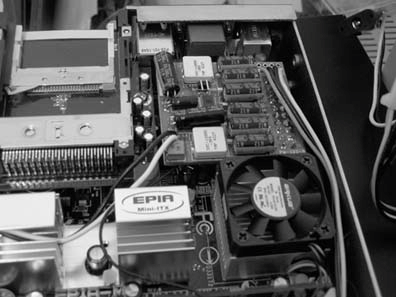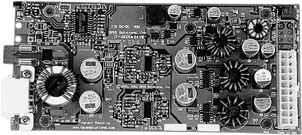Hack42.Power Your Car PC
Hack 42. Power Your Car PC
While you could just use an inverter to power a normal PC AT or ATX power supply, there are several power supplies on the market designed specifically for in-car computer use. An in-car computer must be able to run on 12V, instead of the 120240V found in a house. More accurately, an in-car computer has to put up with a voltage that fluctuates around 1214V when the engine is on, and that can drop well below 12V when the engine is off or while it is starting. Computers are fairly sensitive to voltage fluctuations and can easily get "fried" by voltage spikes. A regulated power supply is a power supply that ensures that its output voltages do not fluctuate significantly. All internal computer power supplies and many external AC adapters are regulated, meaning that minor fluctuations of input voltage do not show up on the output to the motherboard. All laptop computers have batteries, and their battery-charging circuits are usually voltage-regulation circuits as well. Most laptops can run quite easily on 12V; even if they usually expect 18V or some other voltage, you can find power adapters that allow them to run on the 12V available in a car by converting the voltage. iGo (http://www.igo.com) is a good manufacturer of such adapters. Conventional desktop computers, however, are not designed to run on 12V. To provide the indoor AC power they expect, you need to either use an inverter or replace the computer's conventional AC-to-DC power supply with a DC-to-DC power supply. 4.3.1. InvertersTraditional desktop PCs present more of a problem than laptops, because their power supplies expect the 120240V of AC power. You can use an inverter to convert the car's 12V into 120V of AC power suitable for a conventional power supply, but voltage isn't the only issue. You also need to make sure that the inverter can put out enough power. Basic inverters are only rated to 120W, but a top-of-the-line computer with a power-hungry 3D video card can take upwards of 350W. At this wattage, you'll exceed the power available in your cigarette lighter outlet (you might even melt the wire, if the fuse doesn't blow first), so you should wire a high-wattage inverter directly to the car battery. "Put Home Power Outlets in Your Car" [Hack #11] gives the full lowdown on power inverter use. Inverters are in fact DC-to-AC power supplies, which convert a steady 12 14V of DC current into a sine-wave-shaped flow of 120V or 220V AC current (depending on whether you are based in the U.S. or Europe). The drawback of power inverters is that about 20% of the power is lost in this translationthey also have to be switched off when the car is turned off, or they will eventually run down the battery. But if your car PC demands more than about 200W of power, you'll need to use an inverter to power it. 4.3.2. DC-to-DC Power SuppliesMost of the power supplies you are used to are AC-to-DC power supplies. Thus, when you use an inverter, you are converting the 12V DC from the battery up to 120220V AC with the inverter; the computer power supply then converts it back down to 12V and 5V DC, as needed by the motherboard, hard drive, and other components. A more efficient approach is to use a DC-to-DC power supply, which converts the 1214V from the car into the DC voltages needed by the computer. While all computer power supplies are regulated, most of the DC-to-DC power supplies made for smaller PCs can accept only a very narrow input voltage of around 12V. Several companies make DC-to-DC power supplies for automotive use. Morex (http://www.morex.com.tw) makes several units ranging from 60W to 80W, ideal for powering the VIA EPIA series of motherboards. While all of their power supplies are regulated, only one of their power supplies is designed to take fluctuations of automobile input voltage, and that model can't keep the computer on during engine cranking. You have to go beyond Morex to get a suitable in-car power supply.
Mini-box, (also known as iTuner Networks Corp.; http://www.mini-box.com) sells a range of DC-to-DC power supplies for Mini-ITX form factor motherboards. These power supplies are not enclosed like ATX power supplies; they look like circuit boards, but they have the conventional ATX power supply connectors on them. These devices provide up to 200W and some of them have the unique feature of mounting tidily on the EPIA motherboard itself (as you can see in Figure 4-3), without requiring a long ATX power supply cable or taking up more space than the motherboard itself.
Mini-box recently came out with the M1-ATX. This 90W power supply comes in a compact form factor that is a drop-in replacement for the Morex supply found in many Mini-ITX cases (see Figure 4-4). It regulates the full range of car voltages (even during engine cranking), and it goes beyond their already excellent ITPS startup controller, providing several jumper-configurable startup settings. It also prevents dead batteries by automatically shutting down if voltage drops below 11V. Figure 4-3. An iTuner power board mounted neatly on an EPIA motherboard Figure 4-4. An M1-ATX Mpegbox (http://www.mpegbox.net) produces a 70W ATX standard DC-to-DC power supply. This can power any of the VIA EPIA boards, as well as any older ATX motherboards (up to a 700-MHz Pentium III), and it can maintain voltage through engine cranking. Finally, Opus Solutions, Inc. (http://www.opussolutions.com) has created a power supply that has everythingvoltage regulation, 150W true ATX power output, and the ability to automatically turn the computer on and off with the car [Hack #43]. It is also considered the best supply for keeping the computer on during engine cranking [Hack #45]. Its main drawbacks are its sizeit doesn't fit in most small casesand its $150200 price tag. This unit can be seen in Figure 4-5. Figure 4-5. The Opus power supply Mini-box's M1-ATX is my current favorite, because it seems to do everything the Opus does (and more) for less than $80. |

